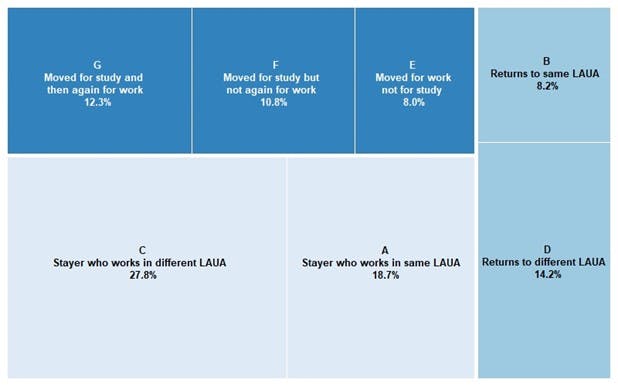Tej Nathwani, principal researcher at HESA, explains a new geographical mobility marker that aims to answer key questions about the movement of graduates around the country
How do universities contribute to their local economy? Do graduates end up working for local employers after completing their studies? Or do they move back home or to another part of the country? These are just some of the questions that have grown in prominence within the higher education sector over recent years.
So, why is this? Well, after almost 15 years of low productivity, growth is high on the macroeconomic priority agenda. That being said, greater importance is now given to the way this is achieved. This is the result of increased focus in policy circles on issues such as the levels of inequality both between and within regions. The ability to achieve inclusive and equitable growth will partially depend on the movement of highly skilled workers into or out of different areas of the country. Naturally, this has led to increased interest in exploring the movement of graduates.
Studies that have examined graduate migration to date have typically done so at a regional level, though this does have its limitations. This can be highlighted through some hypothetical examples. Those graduates who live, study and then work in the same region have previously been referred to as 'loyals', given they remain in one region at all times. Yet, this would mean an individual from Cornwall who attends the University of Plymouth, before finding work in Bristol would be in the same category as someone who lives, studies and works in Bristol. Clearly, the former graduate displays greater levels of mobility than the latter.
Meanwhile, 'returners' have been defined as those who move to another region to study, but return to work in the same region as they originally resided. A person from Blackpool who moves to study at the University of Leeds and then secures employment in Manchester would fall into this pot. The same is true of an individual from Burnley who moves to study at the University of Bradford before returning to Burnley for work. Again, despite both of these graduates showing varying levels of mobility, they are classified in the same category based on a regional analysis.
These illustrations also indicate that when questions are asked about whether graduates work locally after graduation, the truth is that we don't really know if we rely on an exploration at regional level.
A new graduate mobility marker
Over the past year, HESA has developed a new graduate geographical mobility marker that aims to offer a solution to this issue. This marker is formed using the local/unitary authority of residence (prior to beginning higher education), region of study and local/unitary authority (LAUA) of work. For analysis purposes, the marker can be aggregated so that it consists of the following seven categories:
A. Stays in same region for study and finds work in same LAUA as original location of residence.
B. Returns to the same LAUA for work as original location of residence, having left region/country for study.
C. Stays in same region for study, but finds work in different LAUA (in the same region) to original location of residence.
D. Returns to a different LAUA (of the same region) for work when compared with original location of residence, having moved region/country for study.
E. Moved region/country for work, but did not move region for study.
F. Moved region/country for study, but did not then move region/country again for work.
G. Moved region/country for study and then moved region/country again for work (with the region/country being different to their original region/country of residence).
Using Graduate Outcomes data, we subsequently examined the distribution of individuals across this new geographical mobility classification. Our sample included UK-domiciled graduates who completed their higher education course in either 2017/18 or 2018/19 and who noted that their most important activity was paid work for an employer. The exploration produced some intriguing findings.
Figure 1: The distribution of graduates across HESA's new geographical mobility marker.

'Loyals' (based on the regional definition) are individuals who sit within categories A or C and constitute around 45% of the sample. Yet, 60% of these graduates were in pot C and had therefore secured work in a different LAUA to the one in which they initially resided in. Additionally, 'returners' (i.e. those in categories B or D) made up 22% of the dataset, though 63% of these 'returners' did not work in the same LAUA as the one they originally lived in. Earlier, we offered some hypothetical examples of how a regional level analysis may mask the true extent of graduate mobility. A study of our own data reveals this to be the case.
What's next for graduate mobility?
So, what next for research in this field? One area of interest is likely to be an evaluation of how this new geographical mobility marker correlates with early-career outcomes for graduates. For example, in our latest research, we explore the association between graduate mobility and an aspect of job quality (the design and nature of work). The creation of the marker also opens up the possibility in future to enhance our understanding of graduate mobility into/out of LAUAs. In recent years, we have seen an increase in the number of initiatives introduced by providers and/or employers designed to help graduates find work in the local area.
The introduction of this new data item therefore offers the prospect for more detailed insights into the types of questions posed at the start of this piece and to better understand the role higher education plays in developing skills/supporting growth in the local/national economy.
Are there any particular statistics on graduate mobility that you would like to see us produce? If so, please send these through to pressoffice@hesa.ac.uk.
Read HESA's latest research publications and if you would like to be kept updated on the publication plans and latest research releases, please sign-up to our mailing list. To learn more about Graduate Outcomes, visit www.graduateoutcomes.ac.uk or view the latest national level official statistics.
Was this page useful?
Thank you for your feedback
